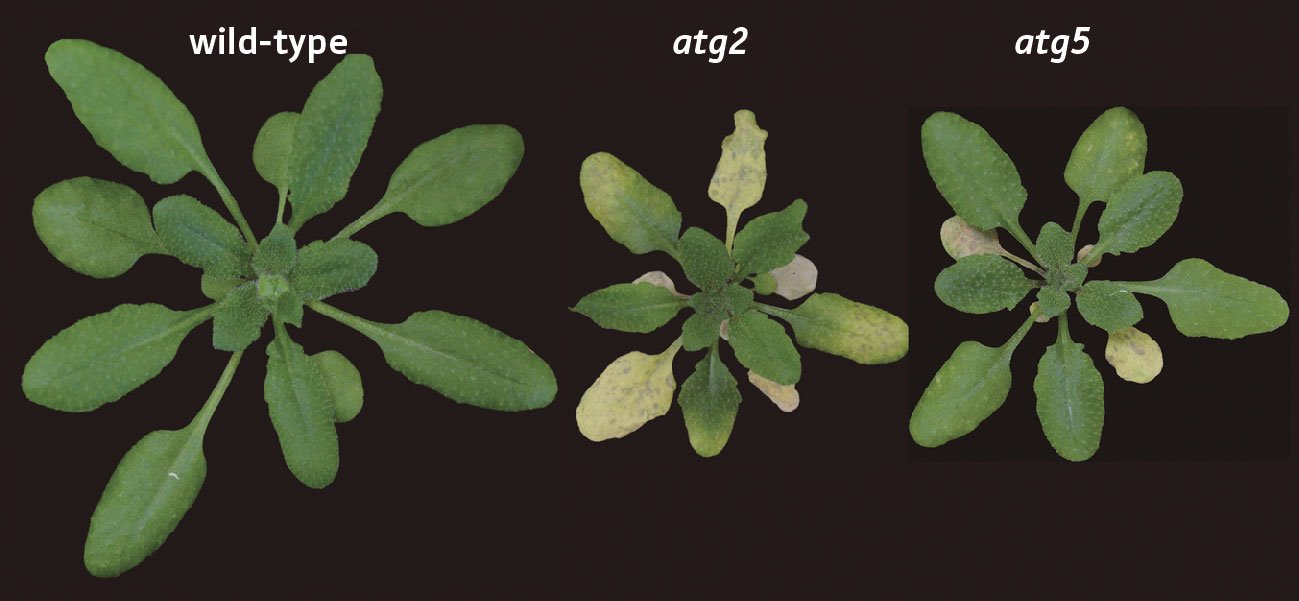Nov. 27, 2009 Research Highlight Biology
Putting the brakes on cell death
Internal degradation within plant cells and their response to aging and disease are linked
 Figure 1: Comparison of a normal Arabiadopsis plant (left) with two mutants under nutrient-rich conditions. All plants were grown under the same environmental conditions for five weeks.
Figure 1: Comparison of a normal Arabiadopsis plant (left) with two mutants under nutrient-rich conditions. All plants were grown under the same environmental conditions for five weeks.
The internal degradation process within cells of higher plants known as autophagy plays a role in limiting programmed cell death in response to infection and aging, according to recent findings by a RIKEN-led research group1. The group has also uncovered important molecular components of the mechanism by which this occurs. Autophagy is known to form the core of plant responses to starvation, so understanding how it works has significant consequences for plant survival under changing environmental conditions.
During autophagy a part of the cell—often including organelles, such as endoplasmic reticulum, Golgi bodies and mitochondria—is engulfed into a vesicle surrounded by a double membrane. This structure then fuses with and delivers its contents to another specialized vesicle full of enzymes that break down the plant molecules into simpler components. The plant can then use these components to build new molecules. Thus, it was long thought that autophagy was simply a mechanism for plants to recycle their molecular resources during times of scarcity.
The ATG genes involved in autophagy, however, are still active under nutrient-rich conditions. To investigate why, Kohki Yoshimoto and colleagues at the RIKEN Plant Science Center in Yokohama, together with researchers from the Japanese National Institute for Basic Biology and the Max Planck Institute for Plant Breeding Research in Germany, undertook biochemical, pharmacological and genetic studies in the plant Arabidopsis of two atg mutants in which autophagy was defective.
Under nutrient-rich conditions, the researchers found that the mutant plants grew quite normally, but showed early signs of senescence or aging and increased sensitivity to infection (Fig. 1). In short, the cells became more likely to undergo programmed cell death from these two causes. They also displayed a build-up of salicylic acid (SA), a signaling compound that stimulates others into action, suggesting that autophagy plays a role in regulating SA signaling.
The researchers then studied plants that were both SA deficient as well as atg mutants, and found this combination suppressed the atg mutant features. The suppression of the mutant characteristics was restored when they added a compound that triggers the same receptors as SA. In addition, autophagy could be induced in wild-type plants by this compound, but not when a critical downstream protein, NPR1, was missing or defective.
Yoshimoto says the team proposes that: “During aging or infection, SA signaling is accelerated, but that also induces autophagy via NPR1, which in turn modulates the SA signaling, limiting cell death.”
References
- 1. Yoshimoto, K., Jikumaru, Y., Kamiya, Y., Kusano, M., Consonni, C., Panstruga, R., Ohsumi, Y. & Shirasu, K. Autophagy negatively regulates cell death by controlling NPR1-dependent salicylic acid signaling during senescence and the innate immune response in Arabidopsis. The Plant Cell 21, 2914-2927 (2009). doi: 10.1105/tpc.109.068635
